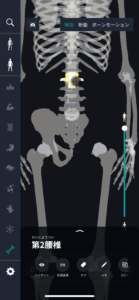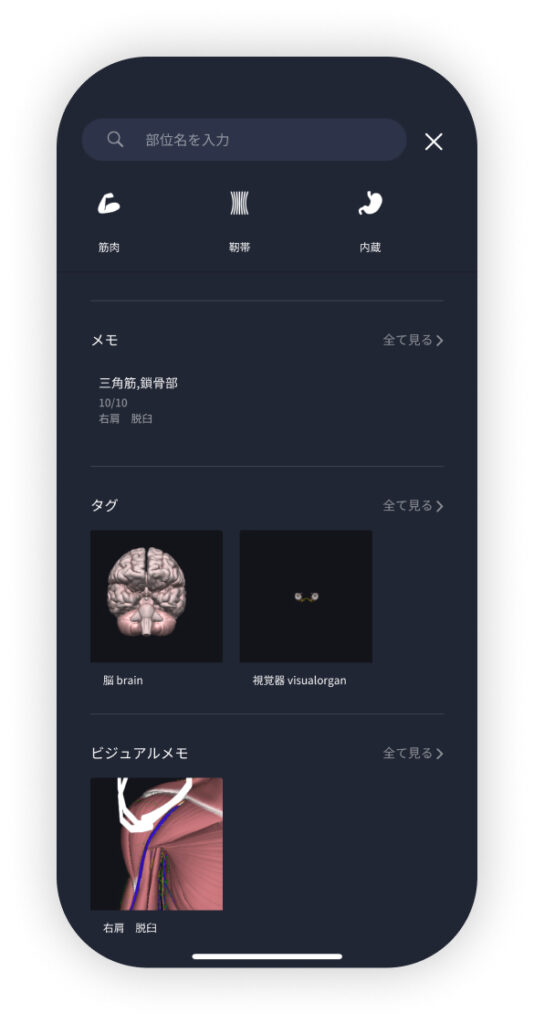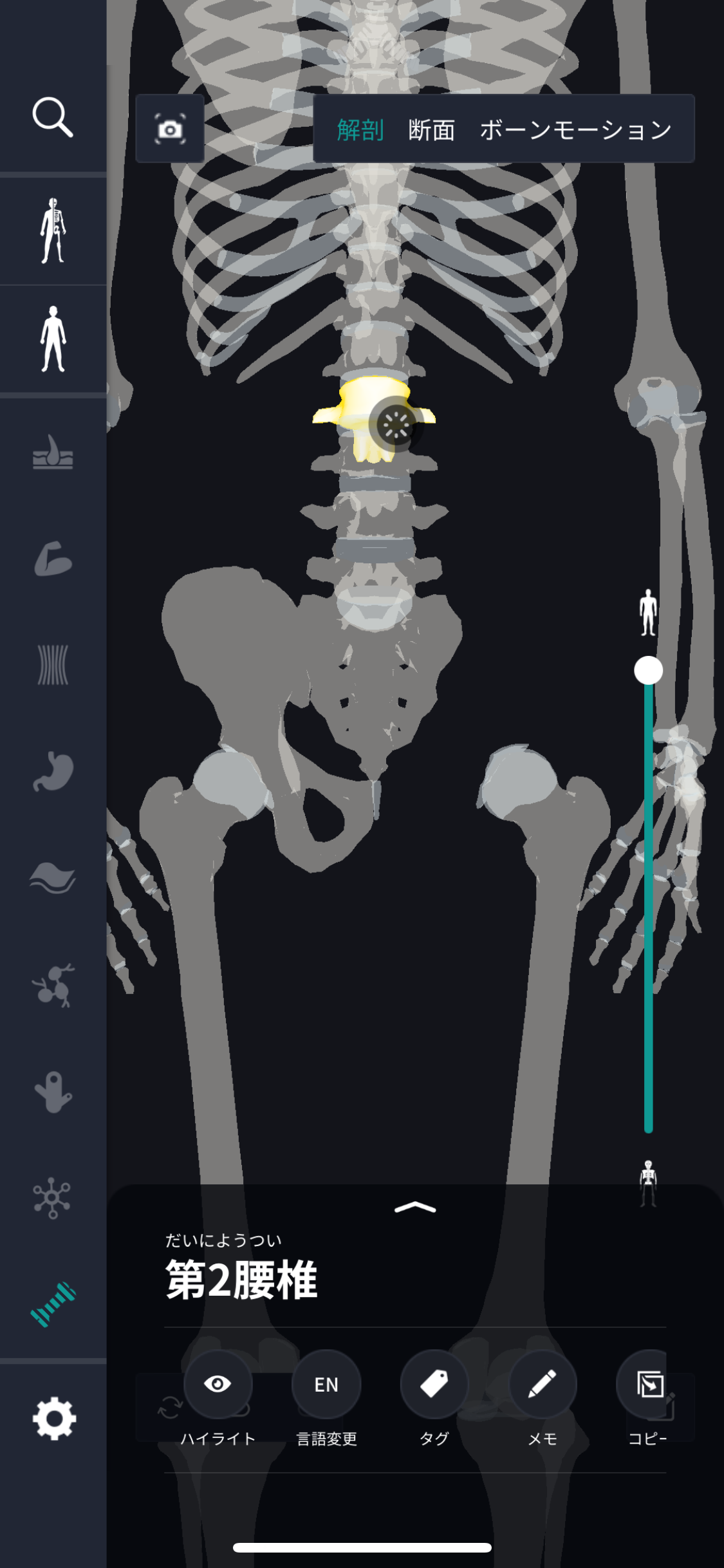beginning
In this article, I will explain effective study methods, starting with knowledge of specialized parts in human anatomy.
In human anatomy, it is necessary not only to memorize the names of various organs, muscles, and bones, but also to remember where they are located in the body. Therefore, it is necessary to learn as efficiently as possible.
I hope you can read this article and use the app to deepen your understanding even a little bit.
Now, I'll explain the details about the “second lumbar vertebra” and how to study human anatomy.
teamLab Body Pro Free Download
A 3D anatomy app that shows all the structures of the human body
Download teamLab Body Pro here!

What is the second lumbar vertebra?
In the anatomy application, you can view a selection of anatomy 3D models. In this model, there are various observation methods such as surfaces, cross-sections, and nervous systems. This time, I'll explain using an anatomy application.
About the second lumbar vertebra

Study points
Location and structure of the second lumbar vertebra
L2 functions as the center of lumbar spine anatomy and is below L1 and above L3. Structurally, a sturdy vertebral body is located in front, which plays the primary load-bearing role. There is a vertebral arch at the back of the vertebral body, which forms the vertebral foramen, which is a channel for the spinal cord. L2 also has spines and transverse processes, and the muscles and ligaments attached to these increase lumbar stability and provide a variety of movements. In particular, these structures contribute to maintaining posture and perform the function of supporting the trunk with the help of abdominal pressure.
The role and function of the second lumbar vertebra
L2 plays an essential role in spinal health and function. First of all, L2 supports pressure from the upper body of the body and distributes weight along with the pelvis. In addition to this critical support function, L2 provides the main lumbar range of motion and enables complex movements such as forward bending, backward bending, side bending, and rotation. Furthermore, the nerve roots surrounding L2 transmit sensory and motor signals to the lower limbs, making a significant contribution to maintaining movement and sensation in everyday life. Furthermore, L2 has a spine structure to absorb shock and prevent excessive stress from being applied to other vertebrae.
English notation for second lumbar vertebra
“Second lumbar vertebra” is expressed as “Second Lumbar Vertebra” in English, and “L2” is common as an abbreviation. This notation has been adopted as a global standard in the fields of medicine and anatomy, and enables quick and clear communication between health care professionals and researchers. “Lumbar” means lower back, and “Vertebra” refers to vertebrae. The number “2” indicates that this bone is equivalent to the second in the lumbar spine. This international standardization makes sharing medical information more efficient and improves the quality of treatment and diagnosis, even in different language environments. This notation facilitates common understanding, especially in situations of medical education, research, and medical cooperation across countries.
How to study human anatomy
I will explain specific study methods using human anatomy applications.
Check your past learning history and practice repeatedly
Here are the steps to check your anatomy learning history and practice iteratively effectively.
1. Check your learning history in the app
Reviewing your learning history with the application is an important step in effectively advancing anatomy learning. First, launch the app and go to the learning history section from the main menu. Many anatomy apps are designed to show your progress in the form of graphs and lists, so you can visually check which parts you've learned about and how much time you've spent.
By using this data, you can understand which areas you have strengths in and where you need to spend more time and effort. We also recommend using a dedicated tag or notebook function to mark areas you are particularly weak at or where you need to relearn. Regularly checking your learning history and looking back on past learning content will lead to efficient review and deepening understanding.
2.Make a plan for iterative learning
Making an efficient repetitive learning plan based on learning history is extremely effective in promoting knowledge retention. First, identify weak points and areas where you need to relearn. Next, arrange these study items into a weekly or monthly calendar and create a specific study schedule. By proceeding in a planned manner, you can learn each part evenly and avoid packing in a large amount of information at once.
Using a task management app or digital calendar to set study reminders is effective. Also, it's important to have the flexibility to regularly review progress and revise plans as needed. By having goals and proceeding with your studies in a planned manner, you can efficiently acquire anatomical knowledge.
3.Use 3D features to learn visually
By utilizing the 3D function, learning anatomy is easier to understand visually. The 3D model shows the structure of the human body three-dimensionally, and each part can be observed in detail. This makes it possible to intuitively grasp positional relationships between deep muscles and organs that are difficult to capture in a planar view. For example, you can learn even the smallest details by rotating specific muscles and bones and zooming in and out.
Also, there are many apps that have the function of displaying cross-sectional views of each part using a 3D model, which is useful for deepening understanding of internal structures. This diversity of visual information helps with memory retention and improves immediate responsiveness in tests and practice situations. By utilizing the 3D function and learning visually, you can learn anatomy knowledge more deeply and efficiently.
Use the memo function concretely

Test your learning regularly in the form of quizzes
Regularly testing what you've learned in a quiz format is a very effective way to anchor your anatomy knowledge. Quiz-style tests help you objectively grasp your level of understanding and areas you lack while repeating knowledge.
For example, by using a learning app to conduct quizzes every specific period, you can reconfirm what you've learned and strengthen your memory. There are a wide range of quiz formats, such as multiple choice questions, fill-in-the-blank questions, and short answer questions, and each helps understanding from a different angle and develops the ability to utilize various types of knowledge.
Get feedback
If possible, get feedback from other learners and experts. It helps you find your own gaps in understanding and areas for improvement. You can also keep yourself motivated to learn by regularly testing yourself. Feeling a sense of accomplishment and progress increases motivation for continuous learning.
summary
This time, I explained how to study about the “second lumbar spine” using an application!
Thank you for reading this far.
I would be happy if reading this article helped you learn about anatomy.
Learning is a long, never-ending journey, but I sincerely wish you all the best. Let's continue to study together and work hard for the national exam!
Please look forward to the next blog.



